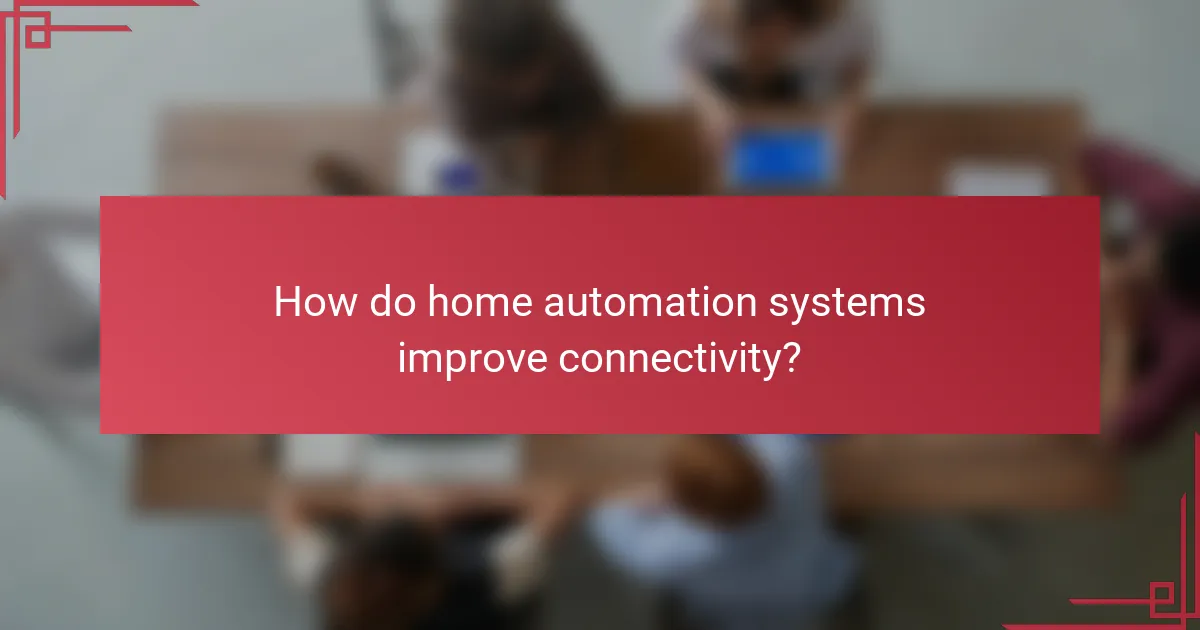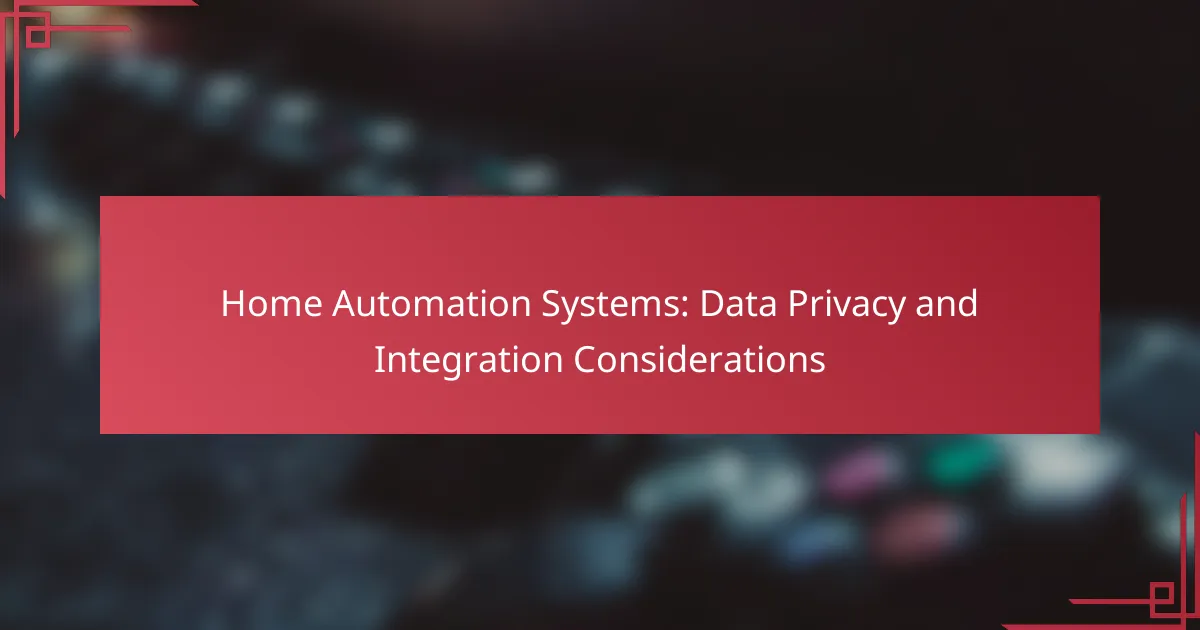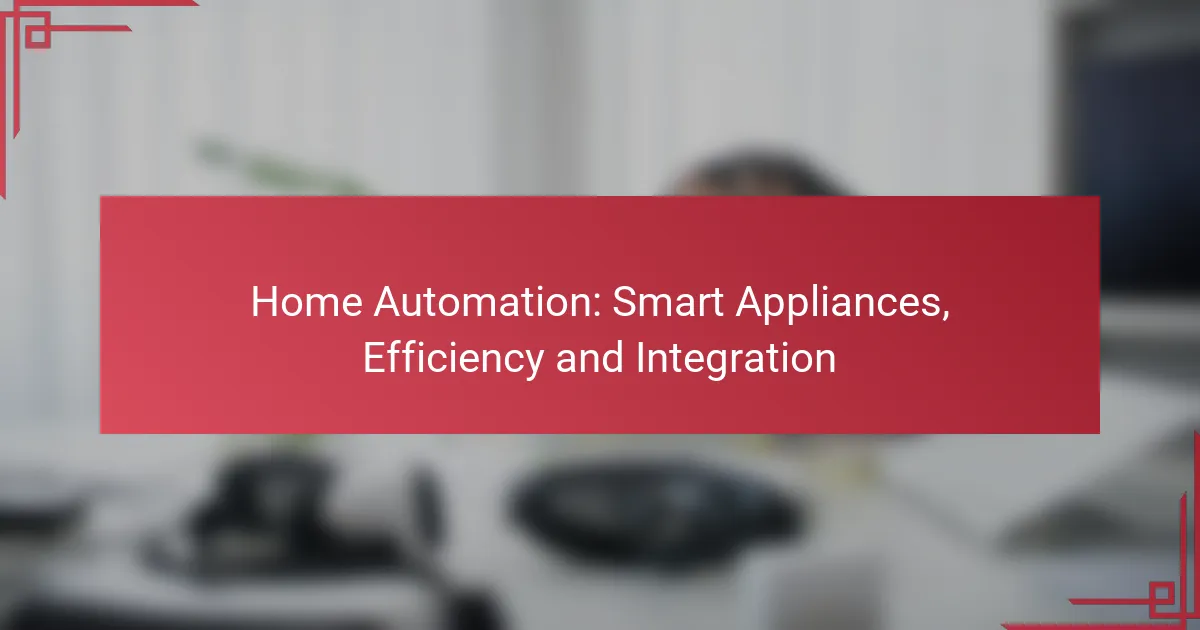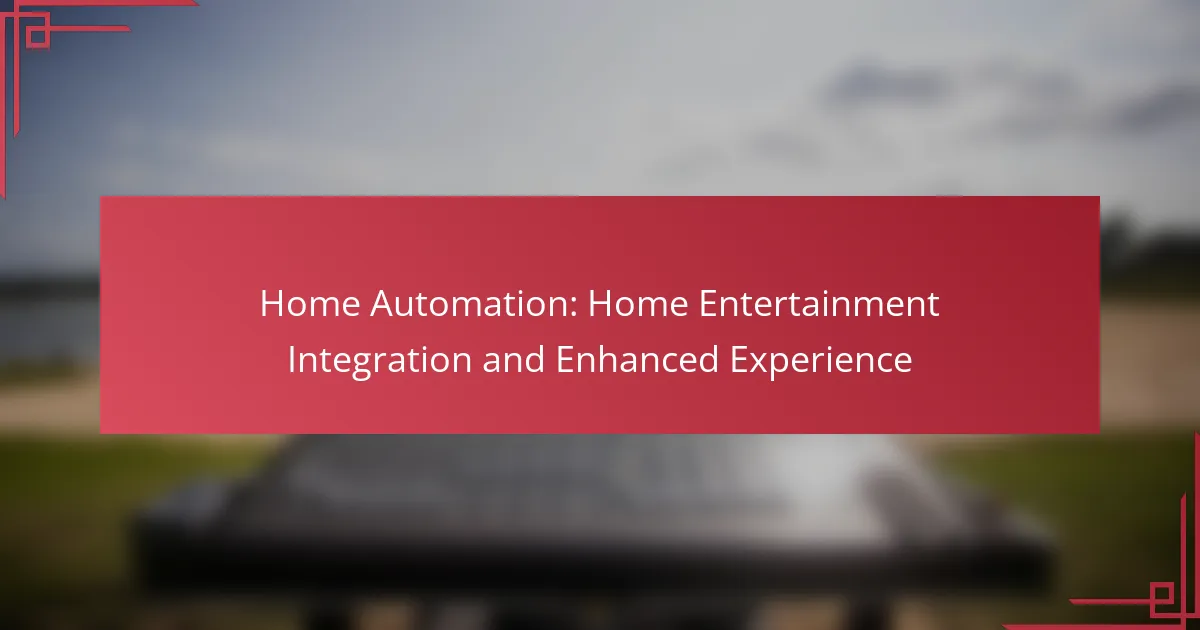Home automation systems are revolutionizing the way we approach security, offering enhanced safety and convenience for homeowners. With features like real-time monitoring and remote access, these smart security solutions seamlessly connect with other devices, creating a cohesive network that simplifies control and boosts efficiency.

What are the benefits of smart security in home automation systems?
Smart security in home automation systems offers enhanced safety, convenience, and peace of mind for homeowners. By integrating advanced technology, these systems provide real-time monitoring, remote access, and seamless connectivity with other smart devices.
Enhanced safety and monitoring
Smart security systems enhance safety by utilizing sensors, cameras, and alarms that monitor your property around the clock. Many systems can detect unusual activity and send alerts directly to your smartphone, allowing for immediate action if needed.
For example, motion detectors can trigger alerts when movement is detected in restricted areas, while surveillance cameras provide live feeds that can be accessed remotely. This constant monitoring significantly reduces the risk of break-ins and vandalism.
Remote access and control
With smart security systems, homeowners can access and control their security features from anywhere using a smartphone or tablet. This remote capability allows users to lock or unlock doors, view camera feeds, and receive notifications about security events in real-time.
For instance, if you forget to lock your front door, you can do so from your phone, ensuring your home remains secure even when you’re away. This level of control adds convenience and reassurance for busy individuals and families.
Integration with other smart devices
Smart security systems can seamlessly integrate with other home automation devices, creating a cohesive smart home environment. This integration allows for coordinated actions, such as turning on lights when a security camera detects movement.
Common integrations include smart locks, doorbell cameras, and environmental sensors. By connecting these devices, homeowners can create customized security protocols that enhance overall safety and convenience.
Cost savings on insurance
Installing a smart security system can lead to significant savings on homeowners insurance premiums. Many insurance companies offer discounts for homes equipped with advanced security features, recognizing the reduced risk of theft and damage.
Homeowners could save anywhere from 5% to 20% on their insurance costs, depending on the system’s features and the insurer’s policies. It’s advisable to check with your insurance provider to understand the specific discounts available.
Increased property value
A smart security system can enhance the overall value of your property. Potential buyers often view homes with advanced security features as more desirable, leading to quicker sales and potentially higher offers.
Investing in smart security not only protects your home but also positions it favorably in the real estate market. Features like smart locks and surveillance cameras can make your property stand out, appealing to tech-savvy buyers looking for modern conveniences.

How do home automation systems improve connectivity?
Home automation systems enhance connectivity by integrating various smart devices into a cohesive network, allowing them to communicate and function together seamlessly. This interconnectedness not only simplifies user control but also enhances security and efficiency in managing home environments.
Wi-Fi and Zigbee protocols
Home automation systems typically utilize Wi-Fi and Zigbee protocols to establish connections between devices. Wi-Fi offers high bandwidth and is suitable for devices that require substantial data transfer, such as security cameras. In contrast, Zigbee is designed for low-power devices, enabling them to communicate over longer distances with minimal energy consumption.
When choosing between these protocols, consider the specific needs of your devices. For instance, if you have multiple sensors spread across a large area, Zigbee may be more effective due to its mesh networking capabilities, which allow devices to relay signals to one another.
Compatibility with smart home platforms
Compatibility with popular smart home platforms like Google Home, Amazon Alexa, and Apple HomeKit is crucial for maximizing the functionality of home automation systems. These platforms allow users to control devices through voice commands or centralized apps, enhancing convenience and user experience.
Before purchasing devices, check their compatibility with your chosen platform to ensure seamless integration. Some devices may require specific hubs or bridges to connect, which can add to the overall cost and complexity of your setup.
Mobile app integration
Mobile app integration is a key feature of home automation systems, enabling users to manage their devices remotely. Most systems come with dedicated apps that allow for real-time monitoring, notifications, and control from anywhere with an internet connection.
When selecting a home automation system, evaluate the quality and usability of its mobile app. Look for features such as customizable alerts, scheduling options, and user-friendly interfaces to enhance your overall experience. Regular updates and support from the app developers can also significantly impact long-term satisfaction.

Which smart security systems are popular in Ireland?
In Ireland, popular smart security systems include devices that enhance home safety and provide remote monitoring capabilities. These systems often integrate with smartphones, allowing homeowners to manage security from anywhere.
Ring Video Doorbell
The Ring Video Doorbell is a widely used smart security device in Ireland that allows homeowners to see and communicate with visitors remotely. It features HD video, night vision, and two-way audio, making it easy to monitor your front door.
Consider the installation process, which is straightforward and can often be done without professional help. However, ensure your Wi-Fi signal is strong at the door location to maintain a reliable connection.
Arlo Pro Security Cameras
Arlo Pro Security Cameras are known for their high-quality video and flexibility in placement, as they can be used indoors or outdoors. They offer features like motion detection, night vision, and cloud storage options for recorded footage.
When choosing Arlo cameras, consider the battery life and whether you prefer wired or wireless options. The subscription plans for cloud storage can add to the overall cost, so evaluate your storage needs before purchasing.
Google Nest Secure
Google Nest Secure is a comprehensive home security system that includes motion sensors, door/window sensors, and a central hub. It integrates seamlessly with other Google smart home devices, allowing for a cohesive smart home experience.
Keep in mind that while Nest Secure offers robust features, it may require a subscription for advanced monitoring services. Assess your budget and desired level of security to determine if this system fits your needs.

What factors should you consider when choosing a home automation system?
When selecting a home automation system, consider factors such as budget, scalability, and customer support. These elements will significantly impact your overall experience and satisfaction with the system.
Budget and pricing options
Your budget is a crucial factor in choosing a home automation system. Prices can vary widely, from a few hundred to several thousand dollars, depending on the complexity and features of the system. It’s essential to evaluate what you need versus what you can afford.
Look for systems that offer tiered pricing or packages that allow you to start small and expand later. This approach can help you manage costs effectively while still achieving your automation goals.
Scalability and future upgrades
Scalability refers to the ability of your home automation system to grow with your needs. Choose a system that allows you to add devices or features over time without requiring a complete overhaul. This flexibility can save you money and hassle in the long run.
Consider systems that are compatible with a wide range of devices and technologies. This compatibility ensures that you can upgrade or expand your system as new technologies emerge or your needs change.
Customer support and warranty
Reliable customer support is vital when dealing with home automation systems. Look for companies that offer comprehensive support options, including online resources, phone assistance, and chat services. A responsive support team can help resolve issues quickly and minimize downtime.
Additionally, check the warranty offered with the system. A good warranty can provide peace of mind and protect your investment. Aim for systems that offer at least a one-year warranty, with options for extended coverage if needed.

How can you enhance your home security with automation?
Enhancing your home security with automation involves integrating smart devices that monitor, control, and protect your property. These systems can provide real-time alerts, remote access, and increased convenience, making it easier to secure your home effectively.
Smart locks and access control
Smart locks allow you to control access to your home remotely, providing a higher level of security than traditional locks. You can grant or revoke access to family members or guests through a smartphone app, eliminating the need for physical keys.
When choosing a smart lock, consider features such as keyless entry, remote locking/unlocking, and integration with other smart home devices. Look for models that offer strong encryption and are compatible with your existing home automation system.
Automated lighting systems
Automated lighting systems can enhance home security by simulating occupancy, deterring potential intruders. By scheduling lights to turn on and off at specific times, you create the illusion that someone is home, even when you’re away.
For effective use, consider installing motion-sensor lights around entry points and programmable indoor lights that can be controlled remotely. This not only improves security but also increases energy efficiency by ensuring lights are only on when needed.



